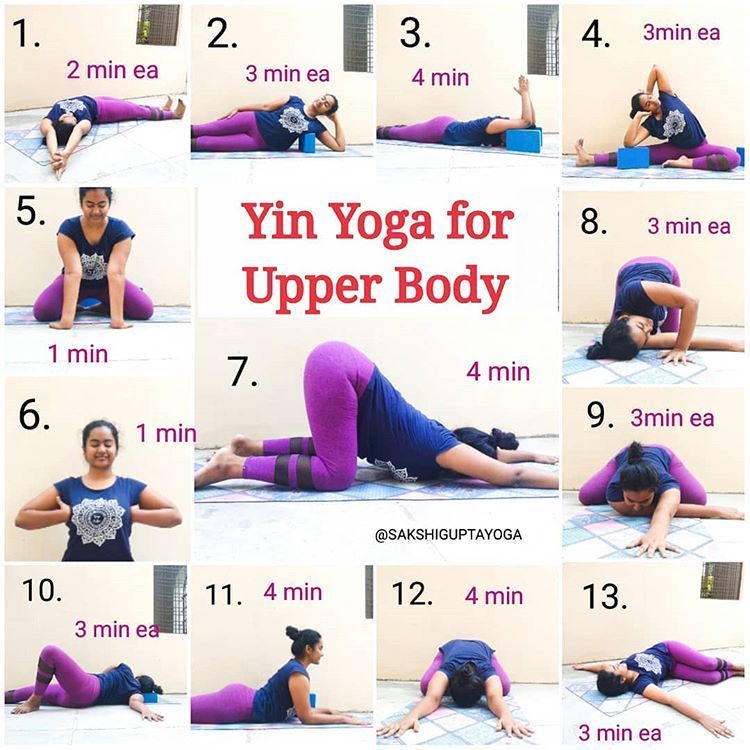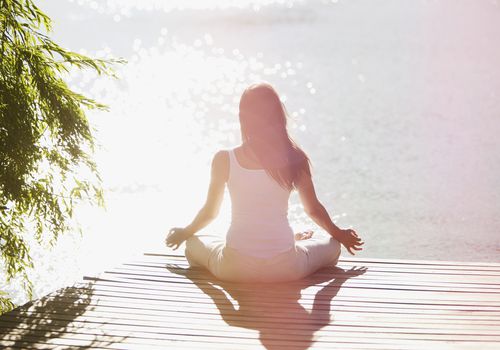
Yoga may help stroke survivors balance better and be more active, according to researchers. These findings were published in Stroke Journal. However, yoga cannot replace rehabilitation. Talk to your doctor about yoga and what poses are best for you. This article provides information on yoga's safety and effectiveness for stroke patients.
A seated position is the best for stroke patients. This position requires that your hands are placed in front and behind your knees. Your right leg should be straight infront of you. Your left leg should be bent behind. The hips should be parallel. Take five to ten sighs before moving on to the next side. You should not force yourself too hard in the beginning when learning the poses. Injury can be caused by exercising too fast. Maintaining a steady pace is key to a healthy body.

It can also be helpful to overcome the physical challenges that often accompany stroke recovery. This can help reduce long-term disability, and allow you to continue your improvement. A stroke is a complication that can cause severe damage to your body. A stroke is caused by a blood clot or ruptured artery. Blood stops flowing to the brain. This causes brain cells and other organs to cease receiving the oxygen they require to function. This can have a negative impact on a person’s memory and muscle control.
You can increase your balance, independence, and quality of life by practicing this practice. Studies show that modified yoga can improve the quality of life and independence for stroke survivors. This is an inexpensive and effective way to improve motor function and balance in this group. It is also good for your health. You can practice yoga at home. The benefits of yoga for stroke survivors are far-reaching and may have a profound impact on your quality of life.
Yoga is good for improving your health and also beneficial for stroke patients. A regular yoga practice will help you increase strength and mobility as well reduce your risk of getting cancerous. You can live a more productive and longer life by improving your physical health. It is important to get treatment as soon as you notice symptoms of stroke. If you feel tired and have difficulty sleeping, you should consider attending a yoga class.

The study also aims improve the quality life of stroke patients. Yoga can improve balance and gait quality. The research conducted by this team focused on the benefits of yoga for stroke patients. The researchers found that people who practiced yoga daily had an improvement in their quality of living and their ability move freely. It is important to do yoga every day if you suffer from stroke. It can also help you recover faster and easier than you think.
FAQ
How can I live my best everyday life?
Find out what makes YOU happy. This is the first step in living a life that you love. Once you are clear about what makes you happy and satisfied, you can move on to the next step. You can also ask other people what they do to live the best lives possible every day.
Dr. Wayne Dyer's book "How to Live Your Best Life" is also available. He talks about how to find happiness and fulfillment at all stages of our lives.
How do I count calories?
You may be wondering "what is the best diet for you?" or "is counting calories necessary?" This depends on your health and lifestyle.
The Best Diet for me - Which One Is Right for You?
The best diet for me depends on my current health status, my personal goals, my preferences, and my overall lifestyle. There are many diets available, some good and others not so good. Some are better for certain people than others. What can I do to make the right choice? How do I make the right decision?
These questions are addressed in this article. This article begins with a brief overview of the various types of diets that are available today. After that, you will learn about the pros and disadvantages of each type. Finally, we'll discuss which one is best.
To begin, let's take a quick look at the different types of diets.
Diet Types
There are three main types: low-fat, high-protein, or ketogenic. Let's take a look at them all below.
Low Fat Diets
A low fat diet means a diet that reduces the intake of fats. This is done by reducing your intake of saturated oils (butter, cream cheeses, etc.). and replacing them with unsaturated fats (olive oil, avocados, etc.). Low fat diets are often recommended to those who wish to lose weight quickly. However, this kind of diet may cause problems such as constipation, heartburn, and indigestion. If a person doesn’t receive enough vitamins from their foods, this can lead to vitamin deficiency.
High Protein Diets
High protein diets discourage carbohydrates and encourage the use of proteins. These diets are more protein-rich than others. These diets can help increase muscle mass and decrease calories. The downside is that they may not provide adequate nutrition for someone who needs to eat regularly. They are also very restrictive, so they might not be appropriate for everyone.
Ketogenic Diets
Ketogenic diets also go by the name keto diets. They are high in fat and moderate in protein and carbs. Athletes and bodybuilders use them because they allow them more time and harder training without feeling fatigued. They do require strict compliance to avoid any side effects like fatigue, headaches, nausea, and headaches.
Exercise: Good for immunity or not?
Your immune system is strengthened by exercise. When you exercise, your body produces white blood cells which fight off infections. You also get rid of toxins from your body. Exercise helps prevent diseases like cancer and heart disease. It also reduces stress levels.
But, too much exercise can lead to a weakening of your immune system. Your muscles can become sore if you exercise too much. This causes inflammation, swelling, and can even lead to death. Your body will then produce more antibodies in order to fight infections. These extra antibodies can lead to allergies or autoimmune disorders.
So, don't overdo it!
What is the best way to eat?
The best diet for you depends on several factors, like your age, gender, weight, health conditions, and lifestyle habits. You also need to consider how much energy you expend during exercise, whether you prefer low-calorie foods, and if you enjoy eating fruits and vegetables.
Intermittent Fasting is an alternative to traditional fasting if you are looking to lose weight. Intermittent eating means that you only eat specific meals throughout the day. This is in contrast to three large meals. You may find that this method works better for you than traditional diets that include daily calorie counts.
Intermittent fasting is believed to increase insulin sensitivity. It may also reduce inflammation. This may lead to a decrease in diabetes risk and blood sugar levels. Other research suggests that intermittent fasting may promote fat loss and improve overall body composition.
Why does our weight change with age
How can you tell if your bodyweight has changed?
If there are less calories than muscle mass, then weight loss is possible. This means that you must consume more calories than you use daily. Reduced activity is the leading cause of weight gain. Others include pregnancy, hormonal imbalances or certain medications. When there is more fat than muscles, it's called weight gain. It occurs when people consume more calories per day than they need. It can be caused by overeating or increased physical activity as well hormonal changes.
The main reason why our bodies lose weight is because we consume fewer calories than we burn. By exercising regularly, our metabolism rates increase which in turn burns more calories during the day. This does not necessarily mean that we will get thinner. What is more important is whether or not our body is losing or gaining weight. Weight loss is possible if you burn more calories than you consume. But if you consume more calories than you burn, you're actually storing them for fat.
As we age we tend to be slower in moving and thus we don't move nearly as much. We also tend eat less than we used to. We tend to gain weight. On the flipside, we are more muscular than we really need and appear bigger.
There's no way to tell how much weight you've lost unless you weigh yourself every week. There are many ways to determine your weight. You can check your waist size, your hips, your thighs, your arms, etc. Some people prefer using bathroom scales and others prefer tape measure.
To track your progress, weigh yourself once a week. Measure your waistline once per month. To see how far you have come, you can take photos of yourself every few month.
You can also look up your height, weight and body measurements online to determine how much you weigh. If you're tall at 5'10", and weigh 180lbs, your weight would be 180.
How can I determine what is best for my health?
You must listen to your body. Your body knows best when it comes to how much exercise, food, and rest you need. It is important to listen to your body to ensure you are not doing too much. Listen to your body and make sure you're doing everything you can to stay healthy.
What is the difference of a virus from a bacteria?
A virus can be described as a microscopic organism that cannot reproduce in another cell. A bacterium is a single-celled organism that reproduces by splitting itself in two. Viruses have a very small size (about 20 nanometers), while bacteria is larger (up to one micron).
Viruses can be spread by contact with bodily fluids containing infected substances, such as saliva, urine and semen. Bacteria can easily be spread from direct contact to contaminated surfaces and objects.
Viral infections can also be introduced to our bodies by a variety of cuts, scrapes or bites. They can also be transmitted through the eyes, nose, mouth, ears, rectum, and anus.
Bacteria can get into our bodies through cuts, scrapes and burns, insect bites, or other skin breaks. They may also be introduced into our bodies through food and water as well as soil, dirt, dust, and animals.
Both bacteria and viruses cause illness. Viruses can not multiply within the host. They can only infect living cells and cause illness.
Bacteria can cause illness by multiplying in the body. They can even invade other parts of the body. Antibiotics are needed to eliminate them.
Statistics
- According to the 2020 Dietary Guidelines for Americans, a balanced diet high in fruits and vegetables, lean protein, low-fat dairy and whole grains is needed for optimal energy. (mayoclinichealthsystem.org)
- According to the Physical Activity Guidelines for Americans, we should strive for at least 150 minutes of moderate intensity activity each week (54Trusted Source Smoking, harmful use of drugs, and alcohol abuse can all seriously negatively affect your health. (healthline.com)
- WHO recommends reducing saturated fats to less than 10% of total energy intake; reducing trans-fats to less than 1% of total energy intake; and replacing both saturated fats and trans-fats to unsaturated fats. (who.int)
- Extra virgin olive oil may benefit heart health, as people who consume it have a lower risk for dying from heart attacks and strokes according to some evidence (57Trusted Source (healthline.com)
External Links
How To
How to stay motivated to stick to healthy eating and exercise
Motivation tips for staying healthy
Motivational Tips To Stay Healthy
-
Make a list with your goals
-
Realistic goals
-
Be consistent
-
Recognize yourself for achieving your goal
-
Don't give up if you fail at first
-
Have fun!